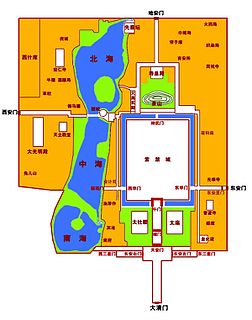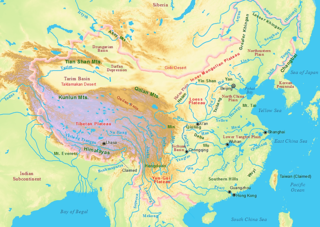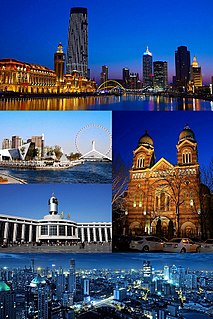
Canals, or navigations, are human-made channels, or artificial waterways, for water conveyance, or to service water transport vehicles.

The Grand Canal, known to the Chinese as the Jing–Hang Grand Canal, a UNESCO World Heritage Site, is the longest as well as the oldest canal or artificial river in the world. Starting at Beijing, it passes through Tianjin and the provinces of Hebei, Shandong, Jiangsu and Zhejiang to the city of Hangzhou, linking the Yellow River and Yangtze River. The oldest parts of the canal date back to the 5th century BC, but the various sections were first connected during the Sui dynasty. Dynasties in 1271–1633 significantly rebuilt the canal and altered its route to supply their capital Beijing.

Linqing is a county-level city under the administration of the prefecture-level city of Liaocheng in western Shandong Province, China.

The Driffield Navigation is an 11-mile (18 km) waterway, through the heart of the Holderness Plain to the market town of Driffield, East Riding of Yorkshire, England. The northern section of it is a canal, and the southern section is part of the River Hull. Construction was authorised in 1767, and it was fully open in 1770. Early use of the navigation was hampered by a small bridge at Hull Bridge, which was maintained by Beverley Corporation. After protracted negotiation, it was finally replaced in 1804, and a new lock was built to improve water levels at the same time. One curious feature of the new works were that they were managed quite separately for many years, with the original navigation called the Old Navigation, and the new works called the New Navigation. They were not fully amalgamated until 1888.

Navigable aqueducts are bridge structures that carry navigable waterway canals over other rivers, valleys, railways or roads. They are primarily distinguished by their size, carrying a larger cross-section of water than most water-supply aqueducts. Although Roman aqueducts were sometimes used for transport, aqueducts were not generally used until the 17th century when the problems of summit level canals had been solved and modern canal systems were developed. The 662-metre (2,172 ft) long steel Briare aqueduct carrying the Canal latéral à la Loire over the River Loire was built in 1896. It was ranked as the longest navigable aqueduct in the world for more than a century, until the Magdeburg Water Bridge in Germany took the title in the early 21st century.

Nankai District is a district of Tianjin, People's Republic of China. Nankai District borders the Hai River in the east and Chentangzhuang Railway in the west and south.

The Great Wall of China is a series of fortifications made of stone, brick, tamped earth, wood, and other materials, generally built along an east-to-west line across the historical northern borders of China to protect the Chinese states and empires against the raids and invasions of the various nomadic groups of the Eurasian Steppe with an eye to expansion. Several walls were being built from as early as the 7th century BC; these were later joined together and made bigger by Qin Shi Huang (220–206 BC), the first Emperor of China. Little of that wall remains. Later on, many successive dynasties have repaired, maintained, and newly built multiple stretches of border walls. The most well-known of the walls were built during the Ming dynasty (1368–1644).

The Imperial City is a section of the city of Beijing in the Ming and Qing dynasties, with the Forbidden City at its center. It refers to the collection of gardens, shrines, and other service areas between the Forbidden City and the Inner City of ancient Beijing. The Imperial City was surrounded by a wall and accessed through seven gates and it includes historical places such as the Forbidden City, Tiananmen, Zhongnanhai, Beihai Park, Zhongshan Park, Jingshan, Imperial Ancestral Temple, and Xiancantan.
The city of Beijing has a long and rich history that dates back over 3,000 years. Prior to the unification of China by the First Emperor in 221 BC, Beijing had been for centuries the capital of the ancient states of Ji and Yan. During the first millennia of imperial rule, Beijing was a provincial city in northern China. Its stature grew in the 10th to the 13th centuries when the nomadic Khitan and forest-dwelling Jurchen peoples from beyond the Great Wall expanded southward and made the city a capital of their dynasties, the Liao and Jin. When Kublai Khan made Dadu the capital of the Mongol-led Yuan dynasty (1279–1368), all of China was ruled from Beijing for the first time. From 1279 onward, with the exception of two interludes from 1368 to 1420 and 1928 to 1949, Beijing would remain as China's capital, serving as the seat of power for the Ming dynasty (1421–1644), the Manchu-led Qing dynasty (1644–1912), the early Republic of China (1912–1928) and now the People's Republic of China (1949–present).

The Ming dynasty, officially the Great Ming or Empire of the Great Ming, founded by the peasant rebel leader Zhu Yuanzhang, known as the Hongwu Emperor, was an imperial dynasty of China. It was the successor to the Yuan dynasty and the predecessor of the short-lived Shun dynasty, which was in turn succeeded by the Qing dynasty. At its height, the Ming dynasty had a population of 160 million people, while some assert the population could actually have been as large as 200 million.

Huangyaguan or Huangya Pass is a small section of the Great Wall of China located in the north of Ji County, Tianjin municipality, approximately 78 miles (126 km) north of urban Tianjin city. The site lies on a steep and abrupt mountain ridge.

The history of canals in China connecting its major rivers and centers of agriculture and population extends from the legendary exploits of Yu the Great in his attempts control the flooding of the Yellow River to the present infrastructure projects of the People's Republic of China. From the Spring and Autumn period onward, the canals of China were used for army transportation and supply, as well as colonization of new territories. From the Qin to the Qing, China's canal network was also essential to imperial taxation-in-kind. Control of shipbuilding and internal tariffs were also administered along the canals.

The history of the Great Wall of China began when fortifications built by various states during the Spring and Autumn and Warring States periods were connected by the first emperor of China, Qin Shi Huang, to protect his newly founded Qin dynasty against incursions by nomads from Inner Asia. The walls were built of rammed earth, constructed using forced labour, and by 212 BC ran from Gansu to the coast of southern Manchuria.
Ji or Jicheng was an ancient city in northern China, which has become the longest continuously inhabited section of modern Beijing. Historical mention of Ji dates to the founding of the Zhou Dynasty in about 1045 BC. Archaeological finds in southwestern Beijing where Ji was believed to be located date to the Spring and Autumn period. The city of Ji served as the capital of the ancient states of Ji and Yan until the unification of China by the Qin Dynasty in 221 BC. Thereafter, the city was a prefectural capital for Youzhou through the Han Dynasty, Three Kingdoms, Western Jin Dynasty, Sixteen Kingdoms, Northern Dynasties, and Sui Dynasty. With the creation of a Jizhou (蓟州) during the Tang Dynasty in what is now Tianjin Municipality, the city of Ji took on the name Youzhou. Youzhou was one of the Sixteen Prefectures ceded to the Khitans during the Five Dynasties. The city then became the southern capital of the Liao Dynasty and then main capital of the Jin Dynasty (1115-1234). In the 13th Century, Kublai Khan built a new capital city for the Yuan Dynasty adjacent to Ji to the north. The old city of Ji became a suburb to Dadu. In the Ming Dynasty, the old and new cities were merged by Beijing's Ming-era city wall.
Du Ji, courtesy name Bohou, was an official who lived in the late Eastern Han dynasty of China. He later served as a high-ranking official in the state of Cao Wei during the Three Kingdoms period. He had the reputation of being a model governor, valiant, loyal and wise. He was the grandfather of Du Yu, the author of the most influential Zuo Zhuan commentary, who gave the work its modern form.

The Ming Great Wall, built by the Ming dynasty (1368–1644), forms the most visible parts of the Great Wall of China today. A comprehensive archaeological survey, using advanced technologies, has concluded that the Ming walls measure 8,850 km (5,500 mi) from Jiayu Pass in the west to the sea in Shanhai Pass, then looping over to terminate in Manchuria at the Hushan Great Wall. This is made up of 6,259 km (3,889 mi) sections of actual wall, 359 km (223 mi) of trenches and 2,232 km (1,387 mi) of natural defensive barriers such as hills and rivers.
Ji Province, also known by its Chinese name Jizhou, was one of the Nine Provinces of ancient China. It is referenced in Chinese historical texts such as the Tribute of Yu, Erya and Rites of Zhou. It consisted of lands north of the Yellow River, including the modern province Hebei, and the municipalities of Beijing and Tianjin.

The Eastern Zhejiang Canal is located in Zhejiang province, China. Its west end is in Xixing Street, Binjiang District, Hangzhou City, crossing Cao'e River and Shaoxing City to its east end, the Yong River estuary in Ningbo City. The canal is 239 kilometres (149 mi) long. Early canal construction took place in the Shanyin old canal in Shaoxing City, in the Spring and Autumn period. In the third century AD, an official named He Xun supervised the construction of Xixing Canal, establishing the complete Eastern Zhejiang Canal.
The Ju River in North China Plain is a major river in the Beijing and Tianjin vicinities. It is a part of Hai River's watershed system. In 354 BCE, State of Yan defeated State of Qi in a battle by this river. In Han dynasty, the original channel of Ju River was widened by Emperor Xian so that it became a navigable river and a major military supply line to the northeast frontier. The total length of Ju River is 206 km, 66 of them are in the Pinggu District of Beijing. Before paved roads were constructed in 1930s, this river was the only transportation route to and from the remote Pinggu region. The river was polluted by industrial wastewater in 1990s. The water quality has been improved in recent years and it has become a water resource for the Pinggu region.

The Ziya River is one of the five major tributaries of Hai River system in northern China. The total length of Ziya River is 730 km (450 mi) and the size of its drainage basin is 78,700 square kilometers (30,400 sq mi). The discharge rate of Ziya River is about 1 m3/s.

















